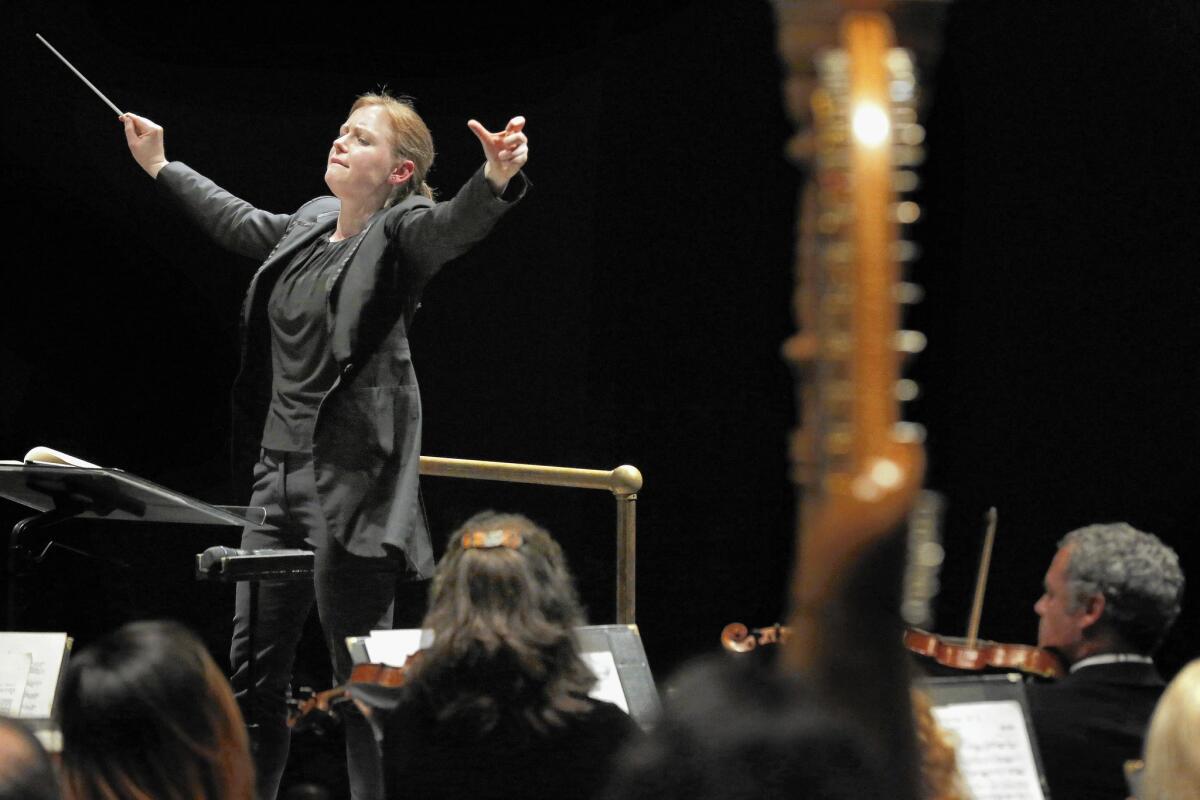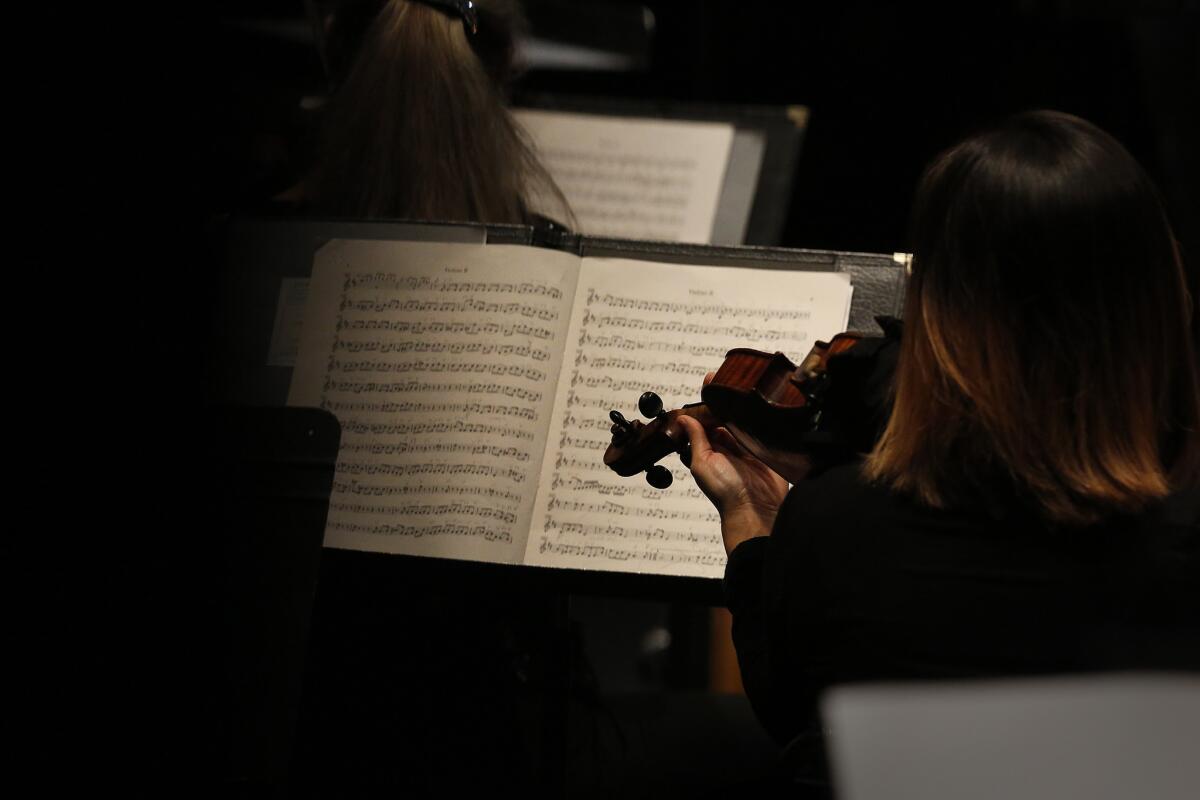Review: Gemma New test-drives the Long Beach Symphony with an interesting, ambitious program

- Share via
The orchestra scene in Southern California is keen for refreshment. Guest conductors at the New West Symphony, the Los Angeles Chamber Orchestra, the San Diego Symphony, the Redlands Symphony and the Long Beach Symphony are auditioning to be music directors. There are more young candidates than seasoned ones. More than ever, women are in demand as are musicians of color.
On Saturday night, it was Gemma New’s turn for a speed date in Long Beach.
A New Zealander, she is a 29-year-old former Dudamel fellow at the Los Angeles Philharmonic, just like her fellow 29-year-old former Dudamel fellow and current L.A. Phil assistant conductor, Mirga Grazinyte-Tyla, who was a contender for San Diego until she snagged the City of Birmingham Symphony in Britain a month ago. Last year, New became music director of the Hamilton Philharmonic in Ontario, Canada. She is also assistant conductor of the New Jersey Symphony and heads the Lunar Ensemble, a new music group in Baltimore.
SIGN UP for the free Classic Hollywood newsletter >>
There was little question Saturday that Long Beach could use a conductor like New. The orchestra is now in its second season since Enrique Arturo Diemecke unexpectedly and unexplainably stepped down after 13 years as music director. It is an orchestra that gives only six classical concerts a season and lacks musical direction. Its home, the Terrace Theater, while in a lively part of town, is too large and acoustically uninviting.
Without a musical vision, the programming is not on the whole imaginative, but New’s program was interesting and ambitious. Ensemble work was uneven, but when it was good, it was quite good. For every negative Saturday, there was a positive; for every disappointment, something of promise.
The big piece was Mahler’s Fourth Symphony. No doubt this was happenstance that New’s mentor, Gustavo Dudamel, had Mahler’s Third on the L.A. Phil agenda at the same time. The Fourth ends with a merry song about St. Peter in heaven that Mahler originally intended for the Third. But the earlier symphony had already reached epic proportions, so Mahler built a less ambitious lyrical symphony around that song.
To give her soloist, Elissa Johnston, something more to do than come in for a nine-minute movement at the end of the evening, New featured the well-known L.A. soprano in Samuel Barber’s “Knoxville: Summer of 1915” before intermission.

The Long Beach Symphony, conducted by New Zealander Gemma New, at the Long Beach Performing Arts Center.
For the first half, I sat in the orchestra section, and it was not an altogether happy experience. New’s clear and decided beat enforces her excellent rhythm purpose. She conducts more for the players and the music than to make a personal statement. Those are qualities ideal for contrapuntal Bach — the Overture to the Fourth Orchestral Suite was the curtain-raiser — and for a necessary unsweetening of saccharine Barber.
With the orchestra seated near the rear of the large stage, and the three trumpets and timpani off to one side in the back, the sound from my seat was muddy Bach soup. The celebratory flavor of the music was not lost, just the interest.
The interest in “Knoxville” is in how Barber longingly and discreetly handles a not obviously singable prose text. James Agee wistfully recalls a time and place and season when things went unsaid, but with the passage of time, the unspoken haunts, and now it is the fondness that becomes so hard to speak about. Every word needs to be understood, so that the amiable music can make its melancholy point.
But Johnston, while eloquent, required a near operatic manner to rise above the orchestra in this hall. No texts were supplied in the program nor projected on the stage. Barber soup is no more palatable than Bach soup.
For Mahler’s symphony, I moved from my $85 seat to the $20 ones in the top balcony, which was nearly empty. Audiophiles will spend a small fortune on cables and other things to open up opaque sound in their stereo systems, to give a sense of presence and dimension. At Terrace Theater, you can accomplish the same by spending less money. The Mahler up there did not always sound like music being made in the same room as the audience, but you could hear the details, the balances. There was life to the sound.
Best of all, there was sonic sunniness. I suspect most of New’s efforts went into the niceties of ensemble rather than interpretation. Still, her way of enthusing was to enforce bracing contrasts and avoid at all costs any hint of Mahlerian schmaltziness.
Concertmaster Roger Wilkie lavished a delightful sourness on the mistuned fiddling Mahler asks for in the grotesque Scherzo. New kept the Adagio compellingly cool and clear-headed. Johnston did not project as well upstairs as downstairs, or maybe it was that the orchestra projected too well. Again, there were inexcusably no texts supplied.
Picking a music director after a single date tempts fate, and I could not quite sense the chemistry between conductor and an orchestra, which played dutifully some of the time and enthusiastically here and there. Clearly, Long Beach needs a new symphonic deal, and a New deal might be hard to pass up.
More to Read
The biggest entertainment stories
Get our big stories about Hollywood, film, television, music, arts, culture and more right in your inbox as soon as they publish.
You may occasionally receive promotional content from the Los Angeles Times.











